2026届高考英语二轮复习:非谓语动词 课件(共28张PPT)
文档属性
| 名称 | 2026届高考英语二轮复习:非谓语动词 课件(共28张PPT) | 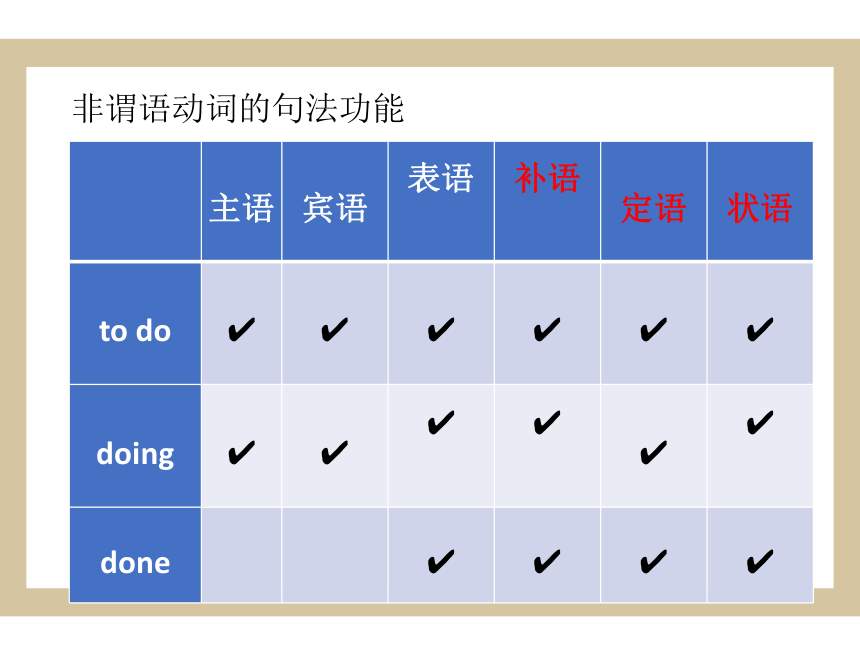 | |
| 格式 | pptx | ||
| 文件大小 | 1.0MB | ||
| 资源类型 | 教案 | ||
| 版本资源 | 通用版 | ||
| 科目 | 英语 | ||
| 更新时间 | 2025-07-28 12:24:18 | ||
图片预览

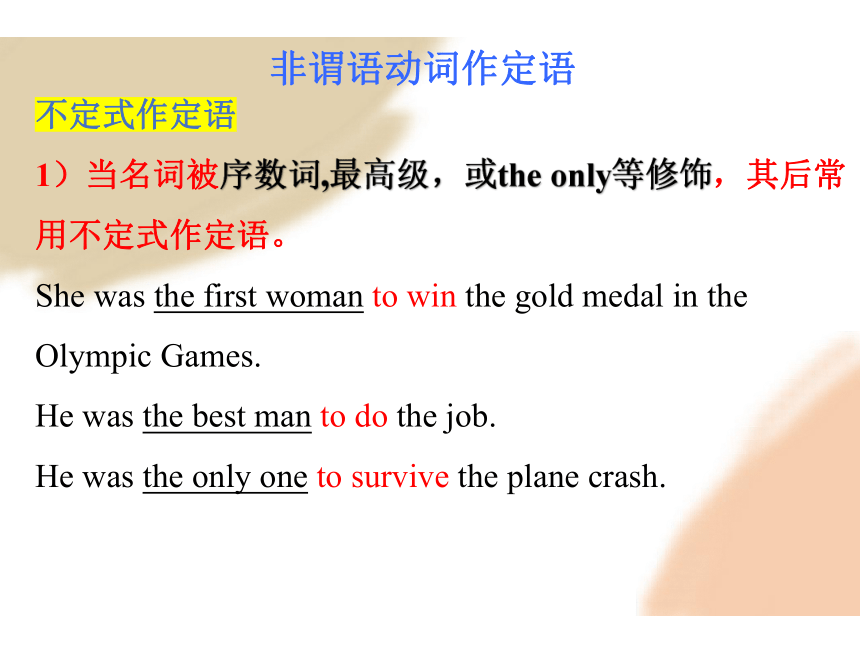
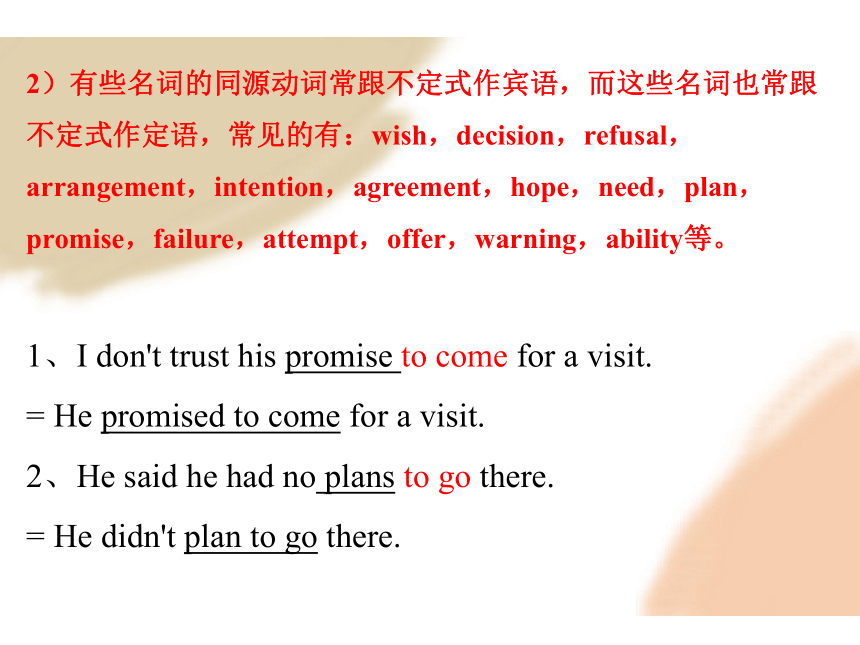
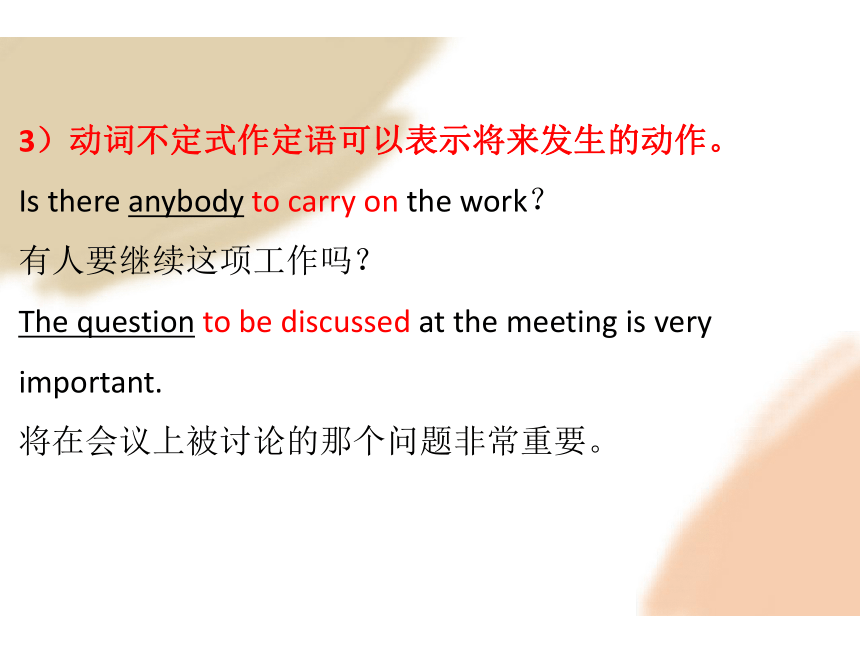
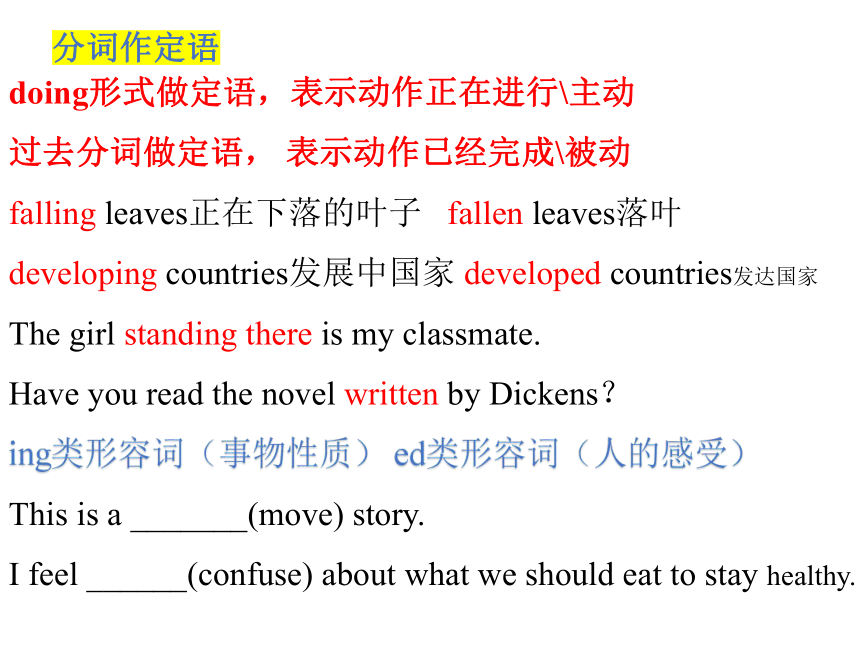
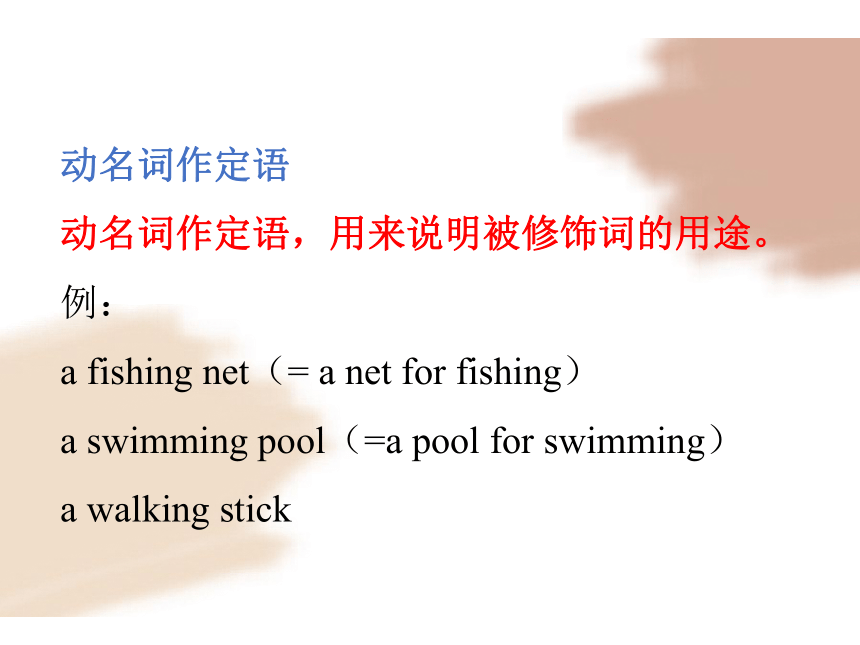
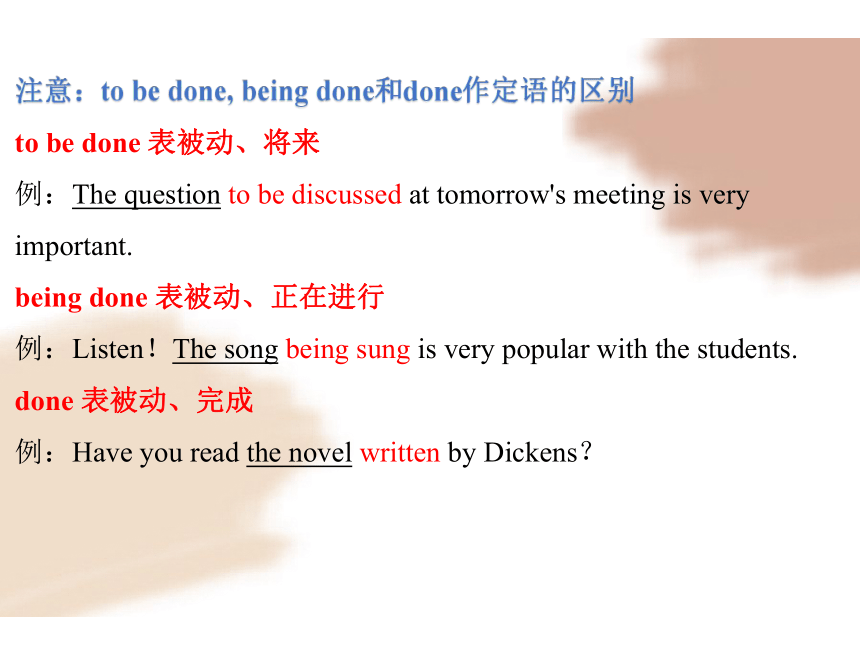
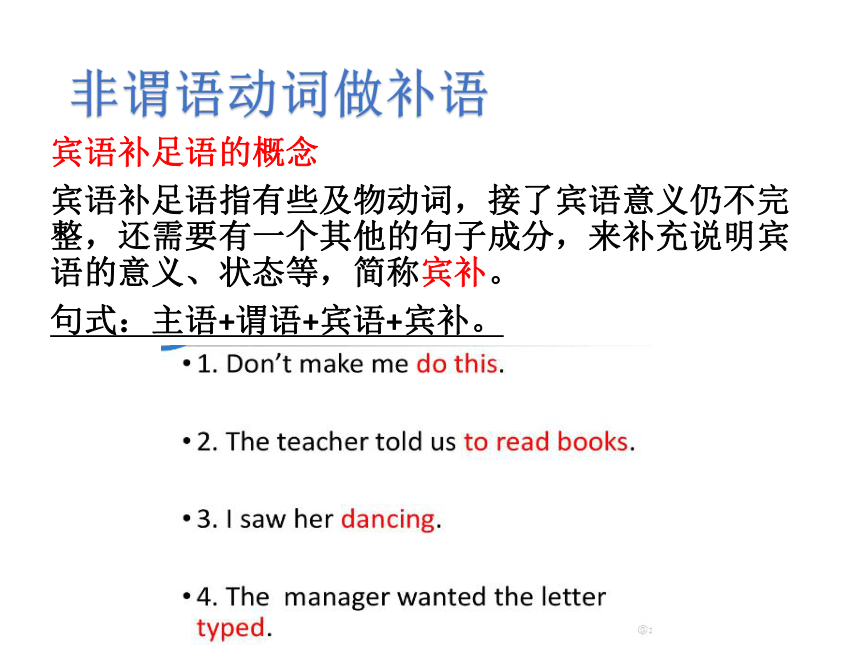
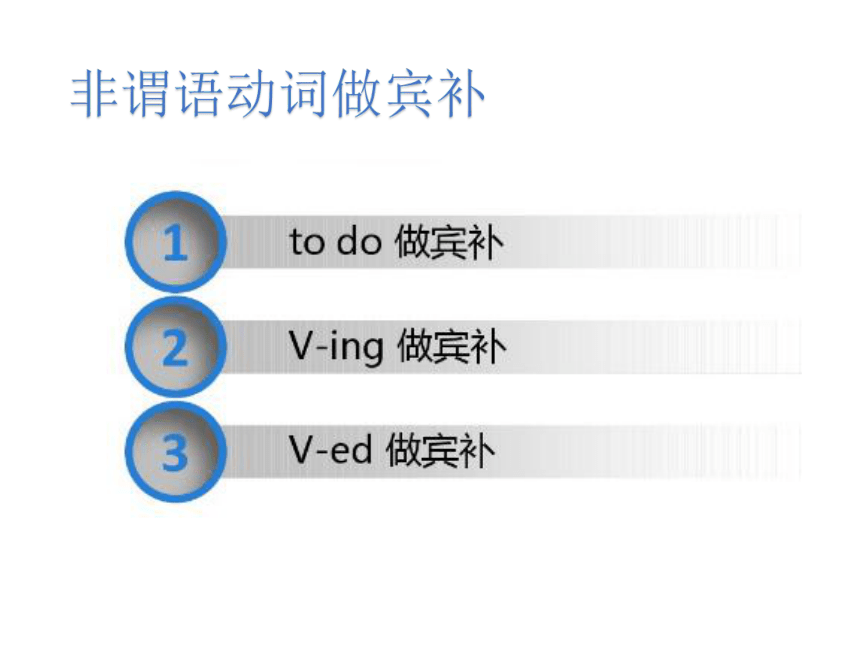
文档简介
(共28张PPT)
非谓语动词的句法功能
主语 宾语 表语 补语 定语 状语
to do
doing
done
非谓语动词作定语
不定式作定语
1)当名词被序数词,最高级,或the only等修饰,其后常用不定式作定语。
She was the first woman to win the gold medal in the Olympic Games.
He was the best man to do the job.
He was the only one to survive the plane crash.
2)有些名词的同源动词常跟不定式作宾语,而这些名词也常跟不定式作定语,常见的有:wish,decision,refusal,arrangement,intention,agreement,hope,need,plan,promise,failure,attempt,offer,warning,ability等。
1、I don't trust his promise to come for a visit.
= He promised to come for a visit.
2、He said he had no plans to go there.
= He didn't plan to go there.
3)动词不定式作定语可以表示将来发生的动作。
Is there anybody to carry on the work?
有人要继续这项工作吗?
The question to be discussed at the meeting is very important.
将在会议上被讨论的那个问题非常重要。
doing形式做定语,表示动作正在进行\主动
过去分词做定语, 表示动作已经完成\被动
falling leaves正在下落的叶子 fallen leaves落叶
developing countries发展中国家 developed countries发达国家
The girl standing there is my classmate.
Have you read the novel written by Dickens?
ing类形容词(事物性质) ed类形容词(人的感受)
This is a _______(move) story.
I feel ______(confuse) about what we should eat to stay healthy.
分词作定语
动名词作定语
动名词作定语,用来说明被修饰词的用途。
例:
a fishing net(= a net for fishing)
a swimming pool(=a pool for swimming)
a walking stick
注意:to be done, being done和done作定语的区别
to be done 表被动、将来
例:The question to be discussed at tomorrow's meeting is very important.
being done 表被动、正在进行
例:Listen!The song being sung is very popular with the students.
done 表被动、完成
例:Have you read the novel written by Dickens?
非谓语动词做补语
宾语补足语的概念
宾语补足语指有些及物动词,接了宾语意义仍不完整,还需要有一个其他的句子成分,来补充说明宾语的意义、状态等,简称宾补。
句式:主语+谓语+宾语+宾补。
非谓语动词做宾补
1.后接不定式做宾补的动词及短语
(1)有些动词或动词短语后接不定式做宾补,即
“动词\动词短语+宾语+to do...”,这类动词有:
She required everyone to follow the rules.
He depends on you to help him with his English.
(2).下列动词或词组接省略to的不定式做宾补。
即“动词\词组+ 宾语+do...”
一感(feel),二听(hear, listen to),
三让(make, have, let),
五看(see, watch, notice, observe, look at)
半帮助 (help)
宾补强调某人做某事的全过程或某事发生的全过程。
Did you hear me sing a song last night
He saw a girl get on the bus.
Please don't make the baby cry again.
Please let me help you (to) clean the kitchen.
变为被动语态时宾补前要加to
Someone observed the thief enter the bank.
The thief was observed to enter the bank.
2.后接分词做宾补的动词
(1)感官动词see,watch, observe, look at,notice, hear,listen to,feel的宾语有四种形式,以see为例。
doing sth 看见...正在做某事
do sth 看见...做了某事
see+宾语 being done 看见...正在被做
done 看见...被做
He saw the thief caught by the police.
I saw him leave a few minutes ago.
Anna saw her sister shouting at her father when she entered the room.
宾语与宾补是主动关系
宾语与宾补是被动关系
(2)使役动词make,let,have后接宾补的情况:
make +宾语+ do 让...做某事
done 让...被做
let +宾语+ do 让...做某事
be done 让...被做
have+ 宾语 + do 让...做某事
doing 让...一直做某事
done 让...被做
I can't make myself understood.
Don't let your children play with matches.
Let the work be done immediately.
I'll have my bike repaired tomorrow.
让某人一直做某事:
keep sb doing sth
have sb. doing
get sb. doing
leave sb. doing
It's bad for you to leave the water running when you brush teeth.
非谓语动词作状语
不定式、分词作状语的基本原则
不定式、分词作状语时,其逻辑主语必须与句子的主语保持一致,即不定式、分词作状语,必须和句子的主语存在逻辑上的主动或被动关系,否则一般不能使用不定式、分词作状语。
不定式做状语的句法功能
做目的状语
做结果状语
做原因状语
1)不定式作目的状语
1)不定式作目的状语
形式 位置 例句
to+动词原形 句首,句中 In order to/To make a study of kangaroos,he went to Australia.
He got up early in order to/to catch the first bus.
Her mother plans to fly to Beijing at least four times a year so as to/in order to/to visit her.
in order to+ 动词原形 句首,句中
so as to+ 动词原形 句中
2)不定式作结果状语
3)不定式作原因状语
形容词作表语时,后面可接不定式作原因状语,用以说明产生这种情绪的原因。
常用结构为“主语+系动词 +形容词 +to do ”
常用词:happy, glad, sorry, anxious, proud, disappointed, angry, surprised, ready, delighted, pleased
例:Tom was very happy to see his mother.
I was surprised to find him here.
4)不定式的主动形式表被动意义
在“主语+系动词+表语(形容词)+to do”结构中,句子的主语与动词不定式有逻辑上的被动关系,且形容词表示主语的特征或性质,这时,需用不定式的主动形式表示被动意义。
常用词:easy, hard, difficult, important, impossible, interesting , pleasant, nice , comfortable, safe, dangerous
例:This question is easy to answer.
This book is difficult to understand.
3.分词作状语时其形式的选择
形式 意义
v.ing (doing) 与句子主语为逻辑上的主动关系,与句子谓语动词动作同时发生
having+v.ed (having done)
与句子主语为逻辑上的主动关系,先于谓语动词动作发生
v.ed (done) 与句子主语为逻辑上的被动关系,表完成
being+v.ed (being done) 与句子主语为逻辑上的被动关系,且与谓语动词动作同时发生
having been +v.ed (having been done) 与句子主语为逻辑上的被动关系,且先于谓语动词动作发生
分词做状语的句法功能
做时间状语
做原因状语
做条件状语
做结果状语
做方式、伴随状语
做让步状语
1.分词作时间状语
常用在when , while , before ,since, as 引导的原因状语从句中。
He went through the papers while having breakfast
(= while he was having breakfast).
他边吃早饭边看报纸。
When completed, the road will be open to the public.
(= when it is completed)
这条路在竣工后会正式通车。
When offered help,one often says"Thank you"or"It's kind of you".
2.分词作原因状语
相当于because, since, as 引导的原因状语从句。
Not understanding this, he asked the teacher about it.
= Because he didn ’t understand this,he asked the teacher about it.
因为不理解,关于那个问题他问了老师。
Defeated by his desk mate, he felt discouraged.
= Because he was defeated by his desk mate, he felt discouraged.
由于被同桌打败,他感到气馁。
3.分词作条件状语
相当于 if, unless 引导的条件状语从句。
Working hard, you ’ll succeed.
= If you work hard, you will succeed.
如果努力学习,你会成功的。
Given more time, I can finish the work.
= If I am given more time, I can finish the work.
如果多给我点时间,我就能完成这项工作。
4.分词作结果状语
常用现在分词表示自然而然的结果,分词前可接thus。
Their car was caught in a traffic jam, thus causing the delay.
他们的车被困在拥挤的交通中,因此耽搁了时间。
The fire lasted nearly a month, leaving nothing valuable.
大火持续了近一个月,几乎没剩下什么有价值的东西。
【注意】过去分词一般不作结果状语。
5.分词作方式或伴随状语。
He made the boy sit there, promising he would not hurt him.
他让那个小男孩坐在那边,答应不伤害他。
The teacher came into the lab, followed by some students.
老师走进实验室,身后跟着一些学生。
6.分词作让步状语
相当于though ,although,even if 等引导的让不状语从句。
Warned of the danger, he still went skating on the thin ice. = Though he was warned of the danger, he still went skating on the thin ice.
尽管被警告危险,他依旧在薄冰上滑冰。
Having been told many times, he still repeated the same mistake.
= Though he had been told many times, he still repeated the same mistake.
虽然被告诫过好多次了,但他仍然重复犯同样的错误。
7.独立成分作状语
有些分词或不定式短语作状语,其形式的选择不受上下文的影响,称作独立成分。
例:
Considering your health, you'd better have a rest.
考虑到你的健康,你最好休息一下。
To tell you the truth, I'm a little tired.
说实话,我有点累。
非谓语动词的句法功能
主语 宾语 表语 补语 定语 状语
to do
doing
done
非谓语动词作定语
不定式作定语
1)当名词被序数词,最高级,或the only等修饰,其后常用不定式作定语。
She was the first woman to win the gold medal in the Olympic Games.
He was the best man to do the job.
He was the only one to survive the plane crash.
2)有些名词的同源动词常跟不定式作宾语,而这些名词也常跟不定式作定语,常见的有:wish,decision,refusal,arrangement,intention,agreement,hope,need,plan,promise,failure,attempt,offer,warning,ability等。
1、I don't trust his promise to come for a visit.
= He promised to come for a visit.
2、He said he had no plans to go there.
= He didn't plan to go there.
3)动词不定式作定语可以表示将来发生的动作。
Is there anybody to carry on the work?
有人要继续这项工作吗?
The question to be discussed at the meeting is very important.
将在会议上被讨论的那个问题非常重要。
doing形式做定语,表示动作正在进行\主动
过去分词做定语, 表示动作已经完成\被动
falling leaves正在下落的叶子 fallen leaves落叶
developing countries发展中国家 developed countries发达国家
The girl standing there is my classmate.
Have you read the novel written by Dickens?
ing类形容词(事物性质) ed类形容词(人的感受)
This is a _______(move) story.
I feel ______(confuse) about what we should eat to stay healthy.
分词作定语
动名词作定语
动名词作定语,用来说明被修饰词的用途。
例:
a fishing net(= a net for fishing)
a swimming pool(=a pool for swimming)
a walking stick
注意:to be done, being done和done作定语的区别
to be done 表被动、将来
例:The question to be discussed at tomorrow's meeting is very important.
being done 表被动、正在进行
例:Listen!The song being sung is very popular with the students.
done 表被动、完成
例:Have you read the novel written by Dickens?
非谓语动词做补语
宾语补足语的概念
宾语补足语指有些及物动词,接了宾语意义仍不完整,还需要有一个其他的句子成分,来补充说明宾语的意义、状态等,简称宾补。
句式:主语+谓语+宾语+宾补。
非谓语动词做宾补
1.后接不定式做宾补的动词及短语
(1)有些动词或动词短语后接不定式做宾补,即
“动词\动词短语+宾语+to do...”,这类动词有:
She required everyone to follow the rules.
He depends on you to help him with his English.
(2).下列动词或词组接省略to的不定式做宾补。
即“动词\词组+ 宾语+do...”
一感(feel),二听(hear, listen to),
三让(make, have, let),
五看(see, watch, notice, observe, look at)
半帮助 (help)
宾补强调某人做某事的全过程或某事发生的全过程。
Did you hear me sing a song last night
He saw a girl get on the bus.
Please don't make the baby cry again.
Please let me help you (to) clean the kitchen.
变为被动语态时宾补前要加to
Someone observed the thief enter the bank.
The thief was observed to enter the bank.
2.后接分词做宾补的动词
(1)感官动词see,watch, observe, look at,notice, hear,listen to,feel的宾语有四种形式,以see为例。
doing sth 看见...正在做某事
do sth 看见...做了某事
see+宾语 being done 看见...正在被做
done 看见...被做
He saw the thief caught by the police.
I saw him leave a few minutes ago.
Anna saw her sister shouting at her father when she entered the room.
宾语与宾补是主动关系
宾语与宾补是被动关系
(2)使役动词make,let,have后接宾补的情况:
make +宾语+ do 让...做某事
done 让...被做
let +宾语+ do 让...做某事
be done 让...被做
have+ 宾语 + do 让...做某事
doing 让...一直做某事
done 让...被做
I can't make myself understood.
Don't let your children play with matches.
Let the work be done immediately.
I'll have my bike repaired tomorrow.
让某人一直做某事:
keep sb doing sth
have sb. doing
get sb. doing
leave sb. doing
It's bad for you to leave the water running when you brush teeth.
非谓语动词作状语
不定式、分词作状语的基本原则
不定式、分词作状语时,其逻辑主语必须与句子的主语保持一致,即不定式、分词作状语,必须和句子的主语存在逻辑上的主动或被动关系,否则一般不能使用不定式、分词作状语。
不定式做状语的句法功能
做目的状语
做结果状语
做原因状语
1)不定式作目的状语
1)不定式作目的状语
形式 位置 例句
to+动词原形 句首,句中 In order to/To make a study of kangaroos,he went to Australia.
He got up early in order to/to catch the first bus.
Her mother plans to fly to Beijing at least four times a year so as to/in order to/to visit her.
in order to+ 动词原形 句首,句中
so as to+ 动词原形 句中
2)不定式作结果状语
3)不定式作原因状语
形容词作表语时,后面可接不定式作原因状语,用以说明产生这种情绪的原因。
常用结构为“主语+系动词 +形容词 +to do ”
常用词:happy, glad, sorry, anxious, proud, disappointed, angry, surprised, ready, delighted, pleased
例:Tom was very happy to see his mother.
I was surprised to find him here.
4)不定式的主动形式表被动意义
在“主语+系动词+表语(形容词)+to do”结构中,句子的主语与动词不定式有逻辑上的被动关系,且形容词表示主语的特征或性质,这时,需用不定式的主动形式表示被动意义。
常用词:easy, hard, difficult, important, impossible, interesting , pleasant, nice , comfortable, safe, dangerous
例:This question is easy to answer.
This book is difficult to understand.
3.分词作状语时其形式的选择
形式 意义
v.ing (doing) 与句子主语为逻辑上的主动关系,与句子谓语动词动作同时发生
having+v.ed (having done)
与句子主语为逻辑上的主动关系,先于谓语动词动作发生
v.ed (done) 与句子主语为逻辑上的被动关系,表完成
being+v.ed (being done) 与句子主语为逻辑上的被动关系,且与谓语动词动作同时发生
having been +v.ed (having been done) 与句子主语为逻辑上的被动关系,且先于谓语动词动作发生
分词做状语的句法功能
做时间状语
做原因状语
做条件状语
做结果状语
做方式、伴随状语
做让步状语
1.分词作时间状语
常用在when , while , before ,since, as 引导的原因状语从句中。
He went through the papers while having breakfast
(= while he was having breakfast).
他边吃早饭边看报纸。
When completed, the road will be open to the public.
(= when it is completed)
这条路在竣工后会正式通车。
When offered help,one often says"Thank you"or"It's kind of you".
2.分词作原因状语
相当于because, since, as 引导的原因状语从句。
Not understanding this, he asked the teacher about it.
= Because he didn ’t understand this,he asked the teacher about it.
因为不理解,关于那个问题他问了老师。
Defeated by his desk mate, he felt discouraged.
= Because he was defeated by his desk mate, he felt discouraged.
由于被同桌打败,他感到气馁。
3.分词作条件状语
相当于 if, unless 引导的条件状语从句。
Working hard, you ’ll succeed.
= If you work hard, you will succeed.
如果努力学习,你会成功的。
Given more time, I can finish the work.
= If I am given more time, I can finish the work.
如果多给我点时间,我就能完成这项工作。
4.分词作结果状语
常用现在分词表示自然而然的结果,分词前可接thus。
Their car was caught in a traffic jam, thus causing the delay.
他们的车被困在拥挤的交通中,因此耽搁了时间。
The fire lasted nearly a month, leaving nothing valuable.
大火持续了近一个月,几乎没剩下什么有价值的东西。
【注意】过去分词一般不作结果状语。
5.分词作方式或伴随状语。
He made the boy sit there, promising he would not hurt him.
他让那个小男孩坐在那边,答应不伤害他。
The teacher came into the lab, followed by some students.
老师走进实验室,身后跟着一些学生。
6.分词作让步状语
相当于though ,although,even if 等引导的让不状语从句。
Warned of the danger, he still went skating on the thin ice. = Though he was warned of the danger, he still went skating on the thin ice.
尽管被警告危险,他依旧在薄冰上滑冰。
Having been told many times, he still repeated the same mistake.
= Though he had been told many times, he still repeated the same mistake.
虽然被告诫过好多次了,但他仍然重复犯同样的错误。
7.独立成分作状语
有些分词或不定式短语作状语,其形式的选择不受上下文的影响,称作独立成分。
例:
Considering your health, you'd better have a rest.
考虑到你的健康,你最好休息一下。
To tell you the truth, I'm a little tired.
说实话,我有点累。
